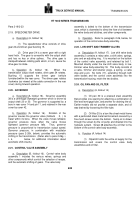TM-5-3805-254-14-P-2 - Page 687 of 894
TRUCK SERVICE MANUAL
Para 2-5/2-8
DESCRIPTION AND OPERATION
the direction of oil flow (when the stator is locked against
rotation), and directs the oil to the pump in a direction
that assists the rotation of the pump.
It is the redirection
of the oil in a manner to assist the pump that enables the
torque converter to multiply input torque.
(4)
Greatest torque multiplication occurs when
the turbine is stalled and the pump is rotating at its
highest speed.
Torque multiplication decreases as the
turbine rotates and gains speed.
(5)
When turbine speed approaches the
speed of the pump, oil flowing to the stator begins
striking the backs of the stator vanes.
This rotates the stator in the same direction as the
turbine and pump.
At this point, torque multiplication
stops and the converter becomes, in effect, a fluid
coupling.
(6)
Thus, as explained in (1) through (5),
preceding, the torque converter accomplishes three main
functions.
It acts as a disconnect clutch because little
torque is transmitted at engine idle speed.
It multiplies
torque at low turbine/high pump speed to give greater
starting or driving effort when needed.
It acts as a fluid
coupling to efficiently transmit engine torque to the
transmission gearing during drive, other than idle or
starting.
2-6.
LOCKUP CLUTCH
a. Description (B, foldout 7).
The lockup clutch
consists mainly of three elements piston 3, clutch plate 4,
and back plate 5. These elements a r e located inside
the flywheel.
The piston and back plate rotate with the
converter pump.
The clutch plate is located between the
piston and back plate and is splined to the converter
turbine.
b. Operation (B, foldout 7).
The lockup shift valve
directs clutch apply pressure to the lockup clutch piston
when sufficient rotational speed is achieved by the
forward clutch and turbine shaft assembly.
The clutch
apply pressure compresses the lockup clutch plate
between the piston and back plate, locking all three
together.
Thus, the converter pump and turbine are
locked together, and provide a direct drive from the
engine.
As rotational speed of the forward clutch and
shaft assembly decreases, the lockup shift valve will
release the lockup clutch.
2-7.
TORQUE CONVERTER HOUSING
Converter housing 16 (A, foldout 8) is machined from
cast aluminum.
The front of the housing is machined to
mate with an SAE 1 engine flywheel housing.
The rear
of the housing is machined to accept either retarder plate
assembly 2 or 19 (A, foldout 10), or front support and
valve assembly 1 or 30 (B, foldout 10), and transmission
housing 7 (A, foldout 14).
The converter housing
encloses and supports the torque converter elements
and input-driven oil pump assembly 1 (A, foldout 8).
2-9.
OIL PUMP ASSEMBLY
a. Description (A, foldout 8).
Oil pump assembly 1
consists mainly of three elements drive gear 4, d r iv e n
gear 7 and pump body 3.
The oil pump assembly is
680
TRANSMISSION
Back to Top




















